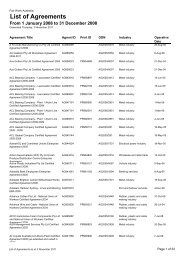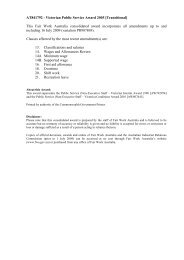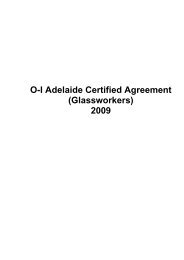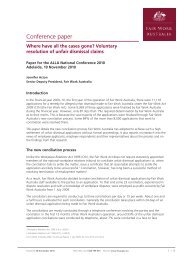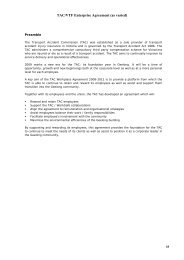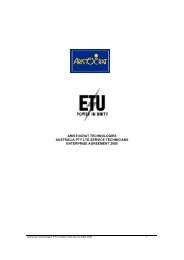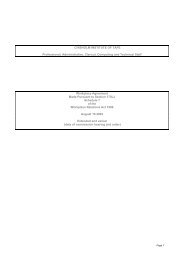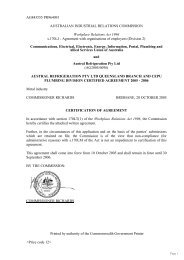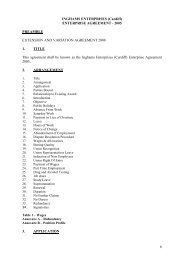GORDON INSTITUTE OF TAFE PACCT STAFF Certified Agreement ...
GORDON INSTITUTE OF TAFE PACCT STAFF Certified Agreement ...
GORDON INSTITUTE OF TAFE PACCT STAFF Certified Agreement ...
You also want an ePaper? Increase the reach of your titles
YUMPU automatically turns print PDFs into web optimized ePapers that Google loves.
<strong>GORDON</strong> <strong>INSTITUTE</strong> <strong>OF</strong> <strong>TAFE</strong><strong>PACCT</strong> <strong>STAFF</strong><strong>Certified</strong> <strong>Agreement</strong> 2005Made Pursuant toSection 170LJof theWorkplace Relations Act 1996Extended and varied by AIRC on XXX 2009
1 TitleThis <strong>Agreement</strong>, made pursuant to Section 170 LJ of the Workplace Relations Act1996, shall be known as the Gordon Institute of <strong>TAFE</strong> <strong>PACCT</strong> Staff <strong>Certified</strong><strong>Agreement</strong> No 4 August 2005 and replaces the Gordon Institute of <strong>TAFE</strong> <strong>PACCT</strong> Staff<strong>Agreement</strong> No 3 2004.2 <strong>Agreement</strong>SUBJECT MATTERTitle<strong>Agreement</strong>Parties BoundDate and Period of OperationDefinitionsObjectives of the <strong>Agreement</strong>Relevant Award for No Disadvantage TestRelationship to AwardRates of Pay and TimingRe-opening of NegotiationsModes of EmploymentContract of EmploymentNotice of TerminationCasual EmploymentWork Outside the Span of HoursHigher Duties AllowancesLong Service LeaveParental LeaveLeave for Jury DutyPurchased LeaveSick Leave – Proof of illnessSalary PackagingSuperannuationPosition Classification ProcedurePerformance Planning and Review<strong>Agreement</strong> Local Consultative CommitteeExploration of Revised Classification StructureProcedures for Preventing and Settling DisputesStaff Disciplinary Policy and ProceduresRedeployment, Retraining and RedundancyPaid Education Leave for Trade Union CoursesReimbursement of ExpensesHuman Resources PoliciesFurther ClaimsSchedule 1 – Classification and Rates ofPay Applying Upon CertificationCLAUSENUMBER12345678910111213141516171819202122232425262728293031323334PAGENUMBER112222-3333-4444-5555-666-8888-9999-101010-11111212-1313-1717-202021212223-27<strong>PACCT</strong> Enterprise <strong>Agreement</strong>-March 2009Page 1
6.2 These measures are designed to support the increased competitiveness andstanding of the Institute through a process of continuous improvement.6.3 The parties agree to work together to develop a committed, flexible and skilledworkforce that is focused on providing high quality customer service and theimplementation of improvements to administrative, financial and technicalprocesses.6.4 The <strong>Agreement</strong> is part of a process aimed at improving productivity andemployee commitment to the Strategic Development of the Institute.7 Relevant Award for No Disadvantage TestThe relevant award for determination by the Commission of the nodisadvantage test is the PR<strong>OF</strong>ESSIONAL, ADMINISTRATIVE, CLERICAL,COMPUTING AND TECHNICAL (<strong>PACCT</strong>) <strong>STAFF</strong> (<strong>INSTITUTE</strong>S <strong>OF</strong> TECHNICALAND FURTHER EDUCATION) VICTORIA AWARD 1999 (AW830232)8 Relationship to AwardThe terms and conditions of the <strong>PACCT</strong> Award 1999 are incorporated into this<strong>Agreement</strong> at the date of certification of the <strong>Agreement</strong>. Where the terms andconditions of the Award are inconsistent with the terms and conditions specified in this<strong>Agreement</strong>, the <strong>Agreement</strong> will prevail.9 Rates of Pay and Timing9.1 After the date of this variation all employees will be entitled to receive a 3.25%increase to their current salary rates of pay in accordance with Schedule 1 ofthis <strong>Agreement</strong>. A further 3.25% increase will be paid on 11 th March 2010 asper Schedule 1.9.2 A payment of $400 will be made to each ongoing and fixed term employee whowas employed by the Institute on 12 th January 2009 and who is still employed(and receiving a salary payment) by the Institute on the date the AIRCapproved this <strong>Agreement</strong>, provided that:• The payment will be pro rata of the $400 for part-time employees;• The payment does not apply to casual employees; and• The payment will be made in the first full pay period on or after this<strong>Agreement</strong> is varied and extended by the AIRC9.3 Award clauses regarding Classification Description and Salaries Table,Clauses 16.1-16.4, shall not apply for the life of this <strong>Agreement</strong>.9.4 Any arbitrated Safety Net Adjustments or other increases that may be grantedto Award salary rates during the life of this <strong>Agreement</strong>, save for those identifiedby Clause 9.5 below, shall be absorbed into the salary rates outlined inSchedule 1 of this <strong>Agreement</strong>.9.5 In the event that any arbitrated Safety Net Adjustments are applied to Awardrates during the life of this <strong>Agreement</strong>, junior employees will have their rates of<strong>PACCT</strong> Enterprise <strong>Agreement</strong>-March 2009Page 3
pay adjusted by the Institute such that they are not disadvantaged had theSafety Net Adjustments been applied to the Professional, Administrative,Clerical, Computing and Technical (<strong>PACCT</strong>) Staff (Institutes of Technical andFurther Education) Victoria (Interim) Award 1999 (AW792652).10 Re-opening of NegotiationsThe parties agree that six months prior to expiration of this <strong>Agreement</strong>, they will reopennegotiations with a view to negotiating a new <strong>Agreement</strong>.11 Modes of EmploymentThe parties are committed to recognising the preferred mode of employment in <strong>TAFE</strong>being ongoing. However the parties also recognise that some fixed-term or casualemployment will continue to be necessary. Such employment will be in accordancewith the terms of the Award and this <strong>Agreement</strong>. It is agreed that fixed-term andcasual employment will not be used to substitute for ongoing employment.12 Contract of Employment12.1 On appointment the Institute shall provide the staff member with a letter ofappointment which stipulates the type of employment and contains thefollowing information:• The date employment is to commence• The date employment is to cease (where applicable)• The classification and rate of pay to be received by the employee• The hours of duty and time/s of attendance of the employee including thetime-fraction to be worked• The other main terms and conditions of employment applicable to theemployee.12.2 The Institute will normally engage staff on fixed-term contracts in circumstanceswhere:• Replacement of staff on leave is required• Funding cannot be regarded as ongoing• New and/or short-term activities and functions are introduced to the Instituteor reducing numbers threaten the viability of an existing area• An employee with specialist skills is required for a limited time• Cover for peak activity is required.<strong>PACCT</strong> Enterprise <strong>Agreement</strong>-March 2009Page 4
12.3 Where a fixed-term employee has two or more years of contiguous fixed-termservice and is engaged on a second or subsequent fixed-term contract ofemployment, and the Institute intends the duties of the employee to becontinued to be performed on an ongoing basis, the employee may apply tohave their mode of employment converted to ongoing employment and theInstitute shall not unreasonably reject such an application.12.4 A full time or part time employee may apply to the Institute for a temporaryadjustment of their position time fraction. The Institute may agree for atemporary adjustment of the time fraction applying to the position for a specifiedperiod of time having regard to the employee’s reasons and the operationalrequirements of the Institute. Reversion to the prior time-fraction shall occur atthe conclusion of the temporary adjustment unless otherwise agreed betweenthe staff member and the Institute.13 Notice of Termination13.1 A permanent or contract employee employed at or above the ‘bottom pay pointof <strong>PACCT</strong> Level 7’ will provide the employer four weeks’ notice in writing of anintention to terminate their employment. All other permanent or contractemployees will be required to give two weeks’ notice of an intention to terminatetheir employment.13.2 The notice period may be varied by agreement between the employee and theemployer.13.3 If an employee fails to give notice, the employer may withhold monies from theemployee in an amount equal to the ordinary rate of pay for the notice period.13.4 Where the employer gives notice of termination it will be in accordance with theAct.13.5 Time off during notice periodAn employee other than a casual or a contract employee who has receivednotice of termination of employment due to being excess to requirements will begranted reasonable leave with full pay during the notice period to investigatealternative job offers or seek appropriate advice or counselling on earlyretirement.14 Casual EmploymentThe Institute shall not employ a person as a casual employee in excess of threemonths or a term, whichever the greater, in any one engagement.15 Work Outside the Span of Hours15.1 An employee may be required to be on duty for one evening each week until8.00 pm. For each hour worked between 6.00-8.00 pm the employee will take<strong>PACCT</strong> Enterprise <strong>Agreement</strong>-March 2009Page 5
1½ hours’ Time Off In Lieu (TOIL) of payment in accordance with the InstituteTOIL Policy.15.2 Employees with primary care responsibilities who seek to be excluded from therequirement to be on duty one evening per week shall not be unreasonablydenied an exclusion.16 Higher Duties Allowances16.1 A full time employee who for a period of 10 or more consecutive working daysis required to act in a position of higher classification than that which theemployee occupies shall be paid an allowance in accordance with the Award.16.2 The higher duties allowance will be paid at level 1 of the higher classification.Where the salary of the higher classification is lower than the current rate ofpay then the next highest classification rate will apply.16.3 An employee performing a proportion of higher duties will be paid at therelevant pro-rata rate.17 Long Service Leave17.1 Entitlement17.1.1 A full time employee shall be entitled to long service leave of 9.1 weeksafter 7 years’ completed service and at the rate of 1.3 weeks for everyadditional year of service thereafter. A part time employee shall be paidon a pro-rata basis.17.1.2 The employer and an employee may agree that the employee may takethe whole or any part of the long service at half pay for a period equal totwice the whole or part of the leave entitlement.17.1.3 Public holidays will not be regarded as part of the leave.17.2 An employee will give six months’ notice of an intention to take long serviceleave. The employer may shorten the notice period at its discretion.17.3 Pro rata payments17.3.1 Where an employee with not less than four completed years of servicedies or is terminated on account of:• retirement;• ill-health; or• excess to requirementsthe employer will pay to the employee or the employee’s personalrepresentative a sum equal to 1/40 of the period of service.17.3.2 Where an employee with not less than seven completed years ofservice resigns or is terminated, the employer will in lieu of long serviceleave, pay to the employee a sum equal to 1/40 of the period of service.<strong>PACCT</strong> Enterprise <strong>Agreement</strong>-March 2009Page 6
17.4 Entitlement eligibilityWhen calculating an employee’s entitlement to long service leave the followingwill be taken into account:17.4.1 Periods of employment in or at:• A State School• A State Department• A State Government instrumentality or authority• A Municipality or other Local Government Authority• A Commonwealth Department• A Commonwealth Department instrumentality or authority (includingthe armed forces)• A University• A College of Advanced Education• <strong>TAFE</strong> Colleges or Institutesprovided that there has not been a break in continuous employment ofmore than 12 months.17.4.2 War service in the Australian Armed Forces which ended not more thanfive years before any other employment which entitled an employee tolong service leave.17.4.3 Aggregated periods of service for a non-continuous employee with anyof the employers listed in 17.4.1.17.4.4 Service where an employee was in receipt of a pension pursuant tos.68(3) of the Superannuation Act 1958 and s.83A of the StateSuperannuation Act 1988 (the successor Act).17.4.5 Service during which an employee took:• Annual leave• Paid sick leave• Paid maternity leave• Paid adoption leave• Paid paternity leave• Any other leave authorised by the employer as counting towardservice.17.4.6 The period of recognised service prior to retrenchment provided that theabsence from continuous employment with an employer listed in 17.4.1was no more than five years.17.4.7 The period of recognised service prior to resignation which in theopinion of the employer was due to special circumstances provided thatthe absence from continuous employment from an employer listed in17.4.1 was no more than five years.<strong>PACCT</strong> Enterprise <strong>Agreement</strong>-March 2009Page 7
17.5 Payment17.5.1 An employee taking long service leave will be entitled to be paid at therate applicable at the time of taking the leave or receiving payment inlieu of leave.17.5.2 Salaries paid while on long service leave will be paid fortnightly or asotherwise agreed between the employee and the employer.18 Parental Leave18.1 EntitlementAfter 12 months continuous service, an employee taking:18.1.1 maternity leave will be entitled to 14 weeks’ leave on full pay plusleave without pay which will not exceed an aggregate of 104 weeks.18.1.2 paternity leave will be entitled to one week on full pay or for periodsthat in aggregate do not exceed five working days plus leave withoutpay which will not exceed an aggregate of 104 weeks.18.1.3 adoption leave will be entitled to 14 weeks on full pay plus leavewithout pay which will not exceed an aggregate of 104 weeks.19 Leave for Jury DutyAn employee required under the Juries Act 1967 as amended to appear and serve asa juror in any court will be entitled to be granted by the CEO leave with pay for theperiod during which the attendance of the employee at court is required. The employeewill not be required to account for any allowances received by him or her.20 Purchased Leave20.1 A full time or part time employee may apply to take up to 10 weeks’ leave in ayear and receive the pro rata salary, which would be payable over the full 52weeks. This will be subject to agreement between the manager and theemployee, and based on the needs of the area. Such arrangements, whereapproved by the Director Organisation Development or other approveddelegate of the CEO, will commence at a mutually agreed time and must betaken in the same year as it is accrued.20.2 Under this arrangement an employee will become a fractional employee, withall benefits accruing on that basis. Where an employee elects to take up theoption, superannuation contributions for the employee and the employer willreduce on a pro-rata basis.<strong>PACCT</strong> Enterprise <strong>Agreement</strong>-March 2009Page 8
20.3 Employees availing themselves of this option will retain benefits accrued on afull time or fractional time basis to date and would then accrue benefits at thenew fractional rate from the accrual date of effect of the change.20.4 The taking and accrual of recreation leave must be in accordance with therelevant Award clause.20.4.1 The Institute acknowledges and accepts that many employees availingthemselves of the cycle will request leave coinciding with theGovernment Education Department gazetted school holidays.20.5 Employees electing to move to these arrangements will be subject to normalarrangements in respect to the rate of accrual of leave.20.6 The arrangement must be reviewed on a yearly basis between the managerand employee and is subject to the approval of the Director OrganisationalDevelopment or other approved delegate of the CEO, on the continuation of thearrangement.20.7 An employee who terminates his/her services must be paid for the unexpiredperiod of leave at the appropriate fractional rate based on the credit accrued.Where entitlements have accrued at the full time rate any termination paymentmust be made at this rate.20.8 An employee who elects to take up the option may choose to maintain, subjectto the requirements of the relevant superannuation scheme, the employee andemployer’s superannuation contributions on a full time employment basis, andthe Institute shall only be obliged to cover the cost of employer contributions atthe reduced rate.21 Sick Leave – Proof of Illness21.1 A Medical Certificate or Statutory Declaration is required for absences of threedays or more, and when there are more than five absences of any duration in a12 month period.21.2 A maximum of three Statutory Declarations are permitted in any anniversaryyear. A Medical Certificate must be provided for any other absences.22 Salary PackagingEmployees may elect to salary package employment benefits in accordance withGovernment policy, taxation legislation and Institute policy in lieu of salary providedthat their salary as specified in Schedule 1 shall be used for calculating all benefits orentitlements upon cessation of employment.23 Superannuation23.1 The employee will be offered by the employer membership of a complyingsuperannuation fund approved by the Australian Prudential RegulationAuthority. The employer will contribute, or will be deemed to contribute, to this<strong>PACCT</strong> Enterprise <strong>Agreement</strong>-March 2009Page 9
fund or another approved fund an amount in accordance with theCommonwealth Superannuation Guarantee Act 1992.<strong>PACCT</strong> Enterprise <strong>Agreement</strong>-March 2009Page 10
23.2 Vic Super shall be the Institute default fund.23.3 All new employees will be registered in the VicSuper fund administered byVicSuper Pty Ltd unless the employee chooses to nominate an alternativecomplying fund from the register of Complying Superannuation Funds.Employer contributions in line with the Superannuation Guarantee(Administration) Act 1992 will be made to all employees, including those over70 years of age.24 Position Classification Procedure24.1 In the event of a new position being created, the position description shall bedeveloped by the manager.24.2 Where changes to existing positions occur, a revised position description will bedeveloped by the manager, in consultation with the incumbent.24.3 The position description will be recommended by the manager and authorisedby the CEO, or delegate, and forwarded to Human Resources within fiveworking days.24.4 Human Resources will classify positions in line with the Mercer CED JobEvaluation process.24.5 The Institute Consultative Committee will be advised of the outcome prior to theincumbent being notified.24.6 The agreed classification will normally become effective from the date on whicheither the revised position description is agreed to or the new position is filled.24.7 Any disputes shall be dealt with in line with Clause 28, Procedures forPreventing and Settling Disputes.25 Performance Planning and Review25.1 The aim of the Institute’s Performance Planning and Review System is asfollows:• To enhance communication between management and staff• To ensure employees are familiar with the expectations for theirperformance on the job• To ensure employees receive regular feedback on their performance andachievements• To recognise the work of employees and identify their professionaldevelopment needs• To provide the basis for accessing increments on an annual basis.<strong>PACCT</strong> Enterprise <strong>Agreement</strong>-March 2009Page 11
25.2 The process for the implementation of the Performance Planning and ReviewSystem is as follows:The manager and employee will meet to develop a Performance Plan which willdetermine:• Key Result Areas and outcomes• A training and development plan and associated costing to addressdevelopment needs and any performance issues are to be identified.25.3 The timing of the Performance Review will be as follows:• Annual Review• Six monthly follow-up review25.4 Managers will ensure that employees’ position descriptions are up-to-date.25.5 Following a satisfactory annual performance review and the achievement of thekey result areas the manager will recommend the payment of an increment, ifapplicable.25.6 Any employee aggrieved at the recommendation shall have recourse to theProcedures for Preventing and Settling Disputes, outlined in Clause 28 in this<strong>Agreement</strong>.26 <strong>Agreement</strong> Local Consultative Committee26.1 The Local Consultative Committee shall monitor the implementation of this<strong>Agreement</strong>.26.2 The Local Consultative Committee will comprise two representatives of theInstitute and two local branch representatives of the Union. It is recognised thatfrom time to time additional representation on behalf of the Institutemanagement and staff or the Union may be involved.26.3 The Local Consultative Committee will meet quarterly to an agreed schedule todiscuss issues arising from the <strong>Agreement</strong> and any matters contained withinthe <strong>Agreement</strong> on which consultation may be required.26.4 Where the Institute proposes changes which are likely to have significant effecton employees covered by this <strong>Agreement</strong>, the Institute will consult with thoseemployees prior to any changes being implemented. The Institute will alsoconsult with the NTEU through the Local Consultative Committee prior to theproposed changes being implemented.<strong>PACCT</strong> Enterprise <strong>Agreement</strong>-March 2009Page 12
27 Exploration of Revised Classification Structure27.1 During the period of operation of this <strong>Agreement</strong>, the parties agree to exploretranslation to the Award based salary classification structure. This explorationis not a commitment to implement translation and is not binding on either party.In the event that agreement is reached to implement the Award basedclassification structure during the period of operation of this <strong>Agreement</strong>, theparties will apply to vary this <strong>Agreement</strong>.28 Procedures for Preventing and Settling Disputes28.1 The parties to this <strong>Agreement</strong> will observe the following procedures forpreventing and settling disputes arising generally and in the interpretationand/or implementation of the terms of this <strong>Agreement</strong> as well as disputespertaining to the Award.28.2 Normal work should continue during the dispute resolution process unless thereis a reasonable concern on occupational health and safety grounds and neitherparty will take any action likely to exacerbate the dispute.28.3 Where a bona fide safety issue exists, an employee will not work in an unsafeenvironment but will, where appropriate, accept re-assignment to alternativesuitable work in the meantime.28.4 The parties to this <strong>Agreement</strong> will take reasonable and genuine steps toprevent or settle disputes by discussion and, where necessary, by negotiation.Where disputes arise, the following procedures will be observed:28.4.1 The employee(s) will discuss the matter which is the subject to thedispute with the supervisor or manager. Where the matter relates to thebehaviour of the supervisor or manager, the employee(s) may initiallydiscuss the matter with more senior levels of management.28.4.2 Where the dispute is unresolved, further discussions will be arrangedbetween senior management and the employee.28.4.3 The employee may choose to be assisted by a representative who shallbe an employee of the Institute or a local Union representative, wherepossible.28.4.4 Where a dispute is not resolved, at the request of either party, aDisputes Committee will be convened within one working week, unlessagreed otherwise. The Disputes Committee will consist of twonominees of management and two staff nominees of the local branch ofthe Union.28.4.5 The Disputes Committee will attempt to resolve the matter within oneworking week of its first meeting. Any resolution will be in the form ofwritten agreement subject, if necessary, to ratification by either party.<strong>PACCT</strong> Enterprise <strong>Agreement</strong>-March 2009Page 13
29.3 Preliminary Counselling Procedures29.3.1 During the preliminary counselling phase, the supervisor and the staffmember shall resolve difficulties through a counselling process includingcommunication, co-operation, constructive criticism and assistance withspecific training and development.29.3.2 During this phase the supervisor will record the times and dates ofrelevant events within a file or diary maintained by the supervisor.29.3.3 In the event that the matter is resolved satisfactorily within this phase,the diary records shall be destroyed.29.3.4 In the event that the matter is not resolved satisfactorily within thisphase, the records shall be retained by the supervisor and shallsubsequently be destroyed following conclusion of any furtherproceedings under this <strong>Agreement</strong>.29.4 Further Counselling Procedures29.4.1 Should the preliminary counselling procedures not resolve the issue,further action shall be initiated by the service of a first warning in writing,which shall take the form of a statement of the reasons fordissatisfaction and shall propose a time frame for monitoring theprogress of the complaint.29.4.2 Following the service of the first warning, an interview shall beconducted between the supervisor who may be assisted by arepresentative of management and the staff member who may beassisted by an employee of the Institute or a local Union representative,where possible.29.4.3 At this interview the reasons for dissatisfaction as set out in the writtenwarning shall be explained and agreement to a proposed time frameshall be sought.29.4.4 At the conclusion of the interview, a jointly signed statementacknowledging receipt of the first warning and any agreement reachedat the first interview shall be placed on the staff member’s file.29.4.5 The signing of the first warning shall serve only as an acknowledgmentof receipt of the warning.29.4.6 If the matter is resolved, a jointly signed statement to that effect shall beplaced on the staff member’s file.29.4.7 If the matter is not resolved, a second and final written warning may beissued to the staff member by their manager.<strong>PACCT</strong> Enterprise <strong>Agreement</strong>-March 2009Page 15
29.4.8 Following the service of a second and final written warning, an interviewshall be conducted. At the interview the staff member may be assistedby a representative who shall be an employee of the Institute or a localUnion representative, where possible.29.5 Formal Interview29.5.1 At this interview, the manager will:• State clearly the reasons for the second warning.• Specify a date for the conclusion of a non-normal action (that is,action under Clauses 29.1 and 29.3 above).• Signify the matter may be referred to the CEO as a formalcomplaint if desired improvement is not achieved by the date for theconclusion of non-formal action.29.5.2 At the conclusion of the interview a jointly signed statementacknowledging receipt of the second written warning and a copy of anyagreement(s) reached shall be placed on the staff member’s file.29.5.3 The signing of the second warning shall serve only as anacknowledgment of receipt of the warning.29.5.4 If the matter is resolved at the expiration of three months from the dateof the first written warning a jointly signed statement to that effect shallbe placed on the staff member’s file.29.5.5 If the matter is not resolved at the expiration of three months from thedate of the first written warning, formal action may be initiated by thelodging of a formal complaint with the CEO.29.5.6 In the event that a staff member refuses to sign an acknowledgment ofreceipt of a warning the supervisor may confirm the service of suchwarning by means of a Statutory Declaration furnished to the CEO.29.6 Disciplinary Committee of InquiryA matter which may result in disciplinary action against a staff member and isnot resolved must be forwarded to a Disciplinary Committee consisting of twonominated management and two nominated Union representatives. TheCommittee shall recommend to the CEO one of the courses of action outlinedin Clause 29.7 of this Policy.29.7 An Institute Disciplinary Committee of Inquiry shall recommend one of thefollowing courses of action:• That the complaint be dismissed and a letter to that effect be placed on thestaff member’s personal file for a period of 12 months subject to satisfactoryresolution of the issue during this period• That no action be taken• That the staff member be transferred to another position in the same oranother department and paid a salary appropriate to that position<strong>PACCT</strong> Enterprise <strong>Agreement</strong>-March 2009Page 16
• That the staff member be reprimanded• That the staff member’s salary increment be withheld for up to one year• That the staff member be dismissed.29.8 Alternative in Camera Process29.8.1 A staff member in respect of whom proceedings under Clause 29.6have been initiated may choose at any stage to have the matter heardand determined by the CEO or nominee in camera.29.8.2 A staff member who elects to have the matter heard by this processshall have the right to be assisted by a representative, who shall be anemployee of the Institute or a local Union representative, wherepossible.29.9 Lapse of ProceedingsIn the event that a staff member resigns or, that the matters which are thesubject of these procedures are resolved or withdrawn, proceedings initiatedshall lapse.29.10 Provisions for Summary SuspensionThe CEO may summarily suspend for a defined period of time a staff memberfor behaviour considered by the CEO to be of sufficient seriousness to warrantsummary action. Any such action shall only occur pursuant to definedprocedures, including:• Suspension to be on full pay• Written notification of suspension including the grounds of suspension to begiven to the staff member at the time of suspension• A suspended staff member shall not have access to, or remain on, campuswithout the written permission of the CEO• Council shall be advised of the suspension within a defined period of time• The CEO shall initiate an inquiry in accordance with Clause 29.6• In the event that a suspension is lifted by the CEO and the staff memberreturned to duty prior to or during the course of an Inquiry, the CEO shallprovide the staff member with a letter acknowledging there was no case toanswer and any proceedings commenced pursuant to this section shall bediscontinued• In the event that an inquiry constituted in accordance with this sectionrecommends that the complaint be dismissed or that no action be taken, thesuspension shall be lifted forthwith and the CEO shall provide the staffmember with a letter acknowledging the outcome.29.11 Summary DismissalNothing in this <strong>Agreement</strong> shall limit the right of the Institute to dismiss a staffmember whose misconduct is so grave as to warrant summary dismissal.<strong>PACCT</strong> Enterprise <strong>Agreement</strong>-March 2009Page 17
29.12 Referral to External AuthoritiesNothing in this policy restricts the Institute from referring any matter to therelevant State Authority where it is deemed there has been a potential breachof the law.Redeployment, Retraining and Redundancy30.1 Redeployment30.1.1 All organisational restructure proposals which may directly affect theterms, staff conditions and tenure of staff in the Institute will bedetermined in consultation with staff who may be affected by suchchanges and the Union.30.1.2 No positions that may be filled through redeployment will be advertisedexternally until redeployment processes have been completed.30.1.3 When a management decision results in a position becoming surplus toInstitute requirements, the Institute will consider redeployment optionsprior to advising the incumbent of being redundant.30.1.4 Where possible, volunteers will be sought to consider redeployment.The Institute may reject an expression from a volunteer to beredeployed. In the event of insufficient volunteers and following anequitable selection process, the Institute will decide which persons willbe made redundant.30.1.5 Any offer of redeployment will be made in compliance with theprinciples of non-discrimination and equal opportunity.30.1.6 Any alternative positions will be of similar remuneration and timefractions, and where possible classification, and be commensurate withthe skills, qualifications and experience of the staff member. Wherethe new position salary differs, the staff member will be retained onsalary maintenance. If necessary the staff member will be offeredretraining opportunities sufficient to enable the staff member to carryout the primary functions of the new role.30.1.7 Where it is a viable option, the staff member will be offered, in writing,the option of redeployment.30.1.8 The redeployment process will be finalised within eight weeks followingwritten notification to the staff member that their position is redundant(inclusive of the redundancy process).30.1.9 All offers of redeployment will include appropriate counselling,retraining and consultation processes.30.1.10 Where the staff member does not accept the offer of redeployment to aposition of the same or equivalent remuneration (on an ongoing basis)and appropriate to their skills, experience and qualifications, that staffmember will be deemed to have resigned.<strong>PACCT</strong> Enterprise <strong>Agreement</strong>-March 2009Page 18
30.1.11 Where the alternative position is offered at a different site (i.e. multisitecampus) and accepted by the staff member, the Institute mayconsider appropriate compensation on a case-by-case basis, providedthe staff member’s initial employment did not envisage mobilitybetween campuses or sites.30.1.12 Staff who are redeployed will maintain all leave and other accruedbenefits pertaining to their former position.30.1.13 Where at the conclusion of the redeployment process no suitablepositions are found, the staff member will be deemed to be retrenchedand the redundancy processes will commence.30.1.14 A suitable alternative position is one where:30.2 Retraining• The employee meets the primary requirements of the position asdetailed in the position description• It would be expected that the employee could perform the duties ofthe position within a reasonable timeframe• The position is equivalent to the position which is redundant interms of remuneration and time fraction and, where possible, noless classification, unless a variation is acceptable to theemployee. (Note: Where a position is of lower classification, salarymaintenance will apply)• The Institute is able to offer appropriate training, counselling andsupport to the employee in the alternative position.30.2.1 Where staff are redeployed, consultation will take place between thestaff member, the releasing manager/supervisor and the acceptingmanager/supervisor to determine retraining needs.30.2.2 Reasonable retraining will be offered where appropriate as part of theredeployment process.30.2.3 Employees will not be expected to retrain for positions that varysignificantly from their professional interest and expertise.30.2.4 Where retraining is undertaken as part of the redeployment processthe staff member and accepting manager/supervisor will develop aclear training plan incorporating:• Expected outcomes• Implementation details• Timelines• Review processes.<strong>PACCT</strong> Enterprise <strong>Agreement</strong>-March 2009Page 19
30.2.5 Training needs are determined through consultation between the staffmember, the releasing manager/supervisor and the acceptingmanager/supervisor.30.2.6 The staff member and the accepting manager/supervisor develop atraining plan outlining:• Training objectives• Training provision (when, where, how, etc)• Timelines• Evaluation and review procedures• Support mechanisms available to the employee.30.2.7 The staff member undertakes retraining activities, and is evaluatedaccording to the training plan.30.2.8 Constant feedback and practical on-the-job support is provided inimplementing the training knowledge acquired.30.2.9 The Institute will be responsible for all required costs incurred inretraining.30.2.10 Retraining authorisation is required before undertaking any trainingactivity.30.3 Redundancy30.3.1 Where the Institute has made a decision that a position(s) isredundant, redeployment will be considered as a primary option priorto any decisions resulting in termination of employment.30.3.2 Prior to implementation of any changes which may result in staff beingredundant, Institute management will consult with staff membersconcerned and the Union regarding reasons for the proposed changes,measures to avoid or minimise the terminations and measures toreduce any adverse effects of any terminations on the staff memberconcerned.30.3.3 For the purposes of such consultation, the Institute will provide inwriting to staff members and the Union all relevant documentationregarding the proposed changes. This will include details of the likelydate and method of implementation of changes, the number andcategory of employees likely to be affected, and the expected effects ofthe change on staff members. Such documentation shall be providedat least two weeks prior to formal consultation.30.3.4 Where the Institute has determined that there are excess staff, therelevant staff and the Union will be provided at least one week prior toformal consultation with details regarding:• The number, classification and location of staff affected who arelikely to be excess to Institute requirements<strong>PACCT</strong> Enterprise <strong>Agreement</strong>-March 2009Page 20
• Proposed changes in staffing structure, projected studentenrolments, planned fee for service activity, the number andclassification of employees affected, and the number andclassification of staff expected to be required for performing thefunctions within the relevant Centre or Enterprise of the Institute• Any other relevant information as may be reasonably requested.30.3.5 Where the staff member rejects an offer of redeployment to a positionof the same or equivalent remuneration that is appropriate to theirskills, experience and qualifications, the staff member will be informedthat they will be deemed to have resigned.30.3.6 Where the Institute is unable to make an offer of redeployment to asuitable alternative position, the staff member will be deemedretrenched.31 Paid Education Leave for Trade Union Courses31.1 A full time or part time employee representative will be granted up to five days’leave with pay to undertake approved training which will enhance the employeerepresentative’s role in dispute resolutions, and implementation of this<strong>Agreement</strong>. The CEO may approve paid leave of absence in excess of fivedays and up to a maximum of 10 days in any one year except that the totalleave granted in that year and the subsequent year shall not exceed 10 days intotal.31.2 Approved training shall include but not be limited to any course, workshop,seminar or like activity carried out as follows:• By or with the support of the National Tertiary Education Union• By or under the auspices of an association of trade unions, the scope,content and level of which course contributes to a better understanding ofindustrial relations.31.3 An application for leave under this clause shall be accompanied by a statementfrom the relevant trade union to the effect that the union has nominated theemployee for the course or supports the employee’s application. Theapplication must be accompanied by a statement detailing dates, times, venue,and content of the education course.31.4 Leave granted under this section:• Shall be on full pay which shall include payments which are deemed to bepart of pay for all purposes but shall not include shift penalty and overtimepayment• May include any necessary travelling time in normal working hoursimmediately before or after the education course• Shall count as service for all purposes.<strong>PACCT</strong> Enterprise <strong>Agreement</strong>-March 2009Page 21
31.5 An employee granted leave under this clause shall not be entitled toreimbursement of personal expenses such as fares, accommodation or mealcosts incurred in attending an education course.32 Reimbursement of Expenses32.1 The Institute shall reimburse an employee any prior approved reasonable outof-pocketexpenses actually and necessarily incurred in the course of her or hisauthorised duties. Within Institute Policy, the amount of an expense will beconsidered reasonable where it does not exceed the relevant amount set bythe Australian Taxation Office (ATO) as adjusted from time to time.32.2 Allowable expenses include:• Travelling, accommodation, meals and other incidental expensesassociated with an overnight, or longer, absence from home or part dayduties, including staff development, away from the normal work location• Expenses incurred in the use of private motor vehicles• Any other expenses incurred in the course of the employee’s employmentand authorised by the employer• Ordinarily the Institute will provide transport for employees engaged inauthorised work. Employees may refuse work where transport is notprovided. Where in the course of employment an employee is required touse his or her private motor vehicle, he or she shall be reimbursed mileagecosts subject to obtaining prior approval from the employer to use thevehicle and submission of a declaration stating the date, purpose of the trip,number of kilometres and type of vehicle.33 Human Resources Policies33.1 The Institute has agreed with the NTEU that in conjunction with all otherInstitute Policies, the Human Resources Policy listed below will apply:• Grievance Procedures33.2 This Policy will not be changed during the life of the <strong>Agreement</strong> except throughconsultation. In the event that agreement cannot be reached by consultation, itis agreed that Clause 28, Procedures for Preventing and Settling Disputes, willbe utilised.<strong>PACCT</strong> Enterprise <strong>Agreement</strong>-March 2009Page 22
34 Further ClaimsIt is a term of this agreement that there will be no further claims on matters covered bythe <strong>Agreement</strong> from the date of certification.Grant SutherlandCEOGordon Institute of <strong>TAFE</strong>SignatureNational Tertiary Education UnionTitleWitnessWitnessTitleDate:TitleDate:<strong>PACCT</strong> Enterprise <strong>Agreement</strong>-March 2009Page 23
Schedule 1. Full Time Salary Rates3.25%increase3.25%increase26/08/2007 11/3/2009 11/3/2010Administrative Off, Gr 1 (Jnr)Under 17 years 300 19135.78 19757.69 20399.82at 17 years 301 20445.99 21110.48 21796.58at 18 years 302 22632.50 23368.06 24127.52at 19 years 303 25334.89 26158.27 27008.42at 20 years 304 27805.48 28709.16 29642.21Administrative Off, Gr 1 (Adult) 305 29929.79 30902.51 31906.84306 30568.63 31562.11 32587.88307 31213.13 32227.56 33274.95308 31857.65 32893.02 33962.05309 32496.49 33552.63 34643.09Administrative Off, Gr 2 310 33323.32 34406.33 35524.53311 33966.41 35070.32 36210.10312 34610.91 35735.76 36897.18313 35251.18 36396.84 37579.74Administrative Off, Gr 3 314 36169.88 37345.40 38559.13315 36868.08 38066.29 39303.45316 37570.53 38791.57 40052.30Administrative Off, Gr 4 320 38490.64 39741.59 41033.19321 39253.87 40529.62 41846.83322 39998.73 41298.69 42640.90323 40754.88 42079.41 43446.99Administrative Off, Gr 5 324 42474.98 43855.42 45280.72325 43600.03 45017.03 46480.08326 44722.25 46175.72 47676.43327 45824.69 47313.99 48851.70Administrative Off, Gr 6 330 48430.96 50004.97 51630.13331 49558.84 51169.50 52832.51332 50657.04 52303.39 54003.25<strong>PACCT</strong> Enterprise <strong>Agreement</strong>-March 2009Page 24
Administrative Off, Gr 7 333 53230.81 54960.81 56747.04334 54364.35 56131.19 57955.46335 55495.05 57298.64 59160.84Administrative Off, Gr 8 336 58564.92 60468.28 62433.50337 59993.85 61943.65 63956.82338 61432.67 63429.23 65490.68Administrative Off, Gr 9 340 64995.81 67108.17 69289.19341 66403.53 68561.64 70789.90342 67829.64 70034.10 72310.21Administrative Off, Gr 10 343 73795.53 76193.88 78670.19344 76274.60 78753.52 81313.01345 78753.68 81313.17 83955.85Library Off, Gr 1 346 35399.58 36550.07 37737.94347 35819.35 36983.48 38185.44348 36271.63 37450.46 38667.60Library Off, Gr 2 350 37608.69 38830.97 40092.98351 38942.93 40208.58 41515.35352 40279.99 41589.09 42940.74Library Off, Gr 3 353 36202.38 37378.96 38593.77354 37218.60 38428.20 39677.12355 38981.09 40247.98 41556.03356 40747.82 42072.12 43439.47357 42538.57 43921.07 45348.51358 44412.72 45856.13 47346.46359 46279.80 47783.89 49336.87Library Off, Gr 4 360 48963.81 50555.13 52198.18361 51334.05 53002.41 54724.98362 53718.43 55464.28 57266.87Library Off, Gr 5 363 58564.92 60468.28 62433.50364 59993.85 61943.65 63956.82365 61432.67 63429.23 65490.68<strong>PACCT</strong> Enterprise <strong>Agreement</strong>-March 2009Page 25
Library Off, Gr 6366 64995.81 67108.17 69289.19367 66403.53 68561.64 70789.90368 67829.64 70034.10 72310.21Computer Off, Gr 1 (Jun)380 19490.55 20123.99 20778.02381 20755.52 21430.07 22126.55382 22869.95 23613.22 24380.65383 25479.05 26307.12 27162.10384 27862.01 28767.53 29702.47Computer Off, Gr 1 (Adult)370 31795.45 32828.80 33895.74371 32622.28 33682.50 34777.19372 33480.20 34568.31 35691.78373 33839.21 34938.98 36074.50374 34349.44 35465.80 36618.44375 34605.25 35729.92 36891.14Computer Off, Gr 2385 35678.02 36837.56 38034.78386 36538.77 37726.28 38952.38387 36979.74 38181.58 39422.48388 38715.37 39973.62 41272.76389 39665.17 40954.29 42285.30Computer Off, Gr 3390 40754.88 42079.41 43446.99391 42349.18 43725.53 45146.61392 44002.84 45432.93 46909.50393 45663.56 47147.63 48679.92394 47325.70 48863.79 50451.86395 48993.49 50585.78 52229.82396 50657.04 52303.39 54003.25Computer Off, Gr 4400 53230.81 54960.81 56747.04401 55013.09 56801.02 58647.05402 56789.71 58635.38 60541.03403 58564.92 60468.28 62433.50Computer Off, Gr 5404 62139.36 64158.89 66244.05405 64272.16 66361.01 68517.74406 66403.53 68561.64 70789.90Computer Off, Gr 6407 71060.63 73370.10 75754.63408 73795.53 76193.88 78670.19<strong>PACCT</strong> Enterprise <strong>Agreement</strong>-March 2009Page 26
Technical Off, Gr 1 (Jnr)414 22229.68 22952.14 23698.09415 25088.96 25904.35 26746.24416 28117.83 29031.66 29975.19417 30866.86 31870.03 32905.81Technical Off, Gr 1 (Adult)410 33336.04 34419.46 35538.09411 34247.67 35360.72 36509.94412 35128.21 36269.88 37448.65413 35405.23 36555.90 37743.97Technical Off, Gr 2420 36219.34 37396.47 38611.85421 36880.80 38079.43 39317.01422 37542.26 38762.38 40022.16423 38200.91 39442.44 40724.32424 38862.37 40125.40 41429.47Technical Off, Gr 3Technical Off, Gr 4430 37590.32 38812.01 40073.40431 38544.35 39797.04 41090.45432 39340.08 40618.63 41938.74433 40475.03 41790.47 43148.66434 40954.17 42285.18 43659.45435 41919.51 43281.89 44688.56436 42928.67 44323.85 45764.38437 43782.35 45205.28 46674.45438 44466.43 45911.59 47403.72440 45321.52 46794.47 48315.29441 46549.75 48062.62 49624.65442 47476.93 49019.93 50613.08Technical Off, Gr 5443 48597.74 50177.17 51807.92444 49527.75 51137.40 52799.37445 51018.87 52676.98 54388.99Technical Off, Gr 6446 52177.85 53873.63 55624.52447 53000.43 54722.94 56501.44448 54662.56 56439.09 58273.36<strong>PACCT</strong> Enterprise <strong>Agreement</strong>-March 2009Page 27
Counselling Services Off, Gr 1450 36202.38 37378.96 38593.77451 37218.60 38428.20 39677.12452 38981.09 40247.98 41556.03453 40592.35 41911.60 43273.73454 42538.57 43921.07 45348.51455 44412.72 45856.13 47346.46Counselling Services Off, Gr 2456 46600.63 48115.15 49678.89457 48963.81 50555.13 52198.18458 51334.05 53002.41 54724.98459 53718.43 55464.28 57266.87Counselling Services Off, Gr 3460 58564.92 60468.28 62433.50461 59993.85 61943.65 63956.82462 61432.67 63429.23 65490.68<strong>PACCT</strong> Enterprise <strong>Agreement</strong>-March 2009Page 28


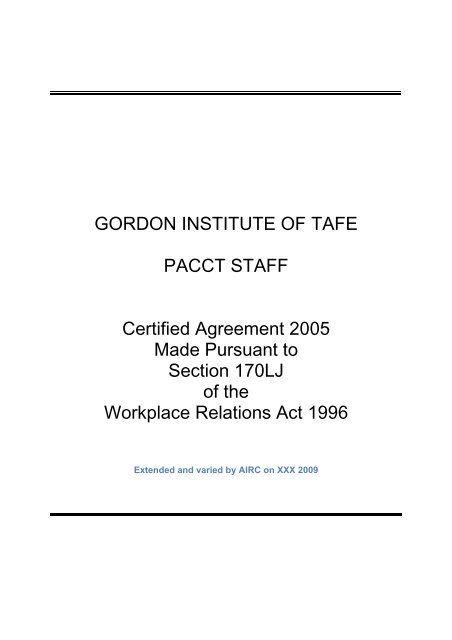
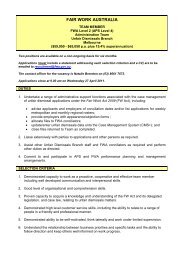
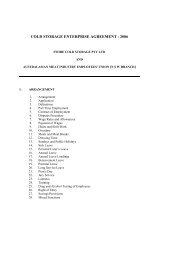

![AT783529 - The Hoyts Award 1999 [Transitional] This Fair Work ...](https://img.yumpu.com/49907847/1/184x260/at783529-the-hoyts-award-1999-transitional-this-fair-work-.jpg?quality=85)

